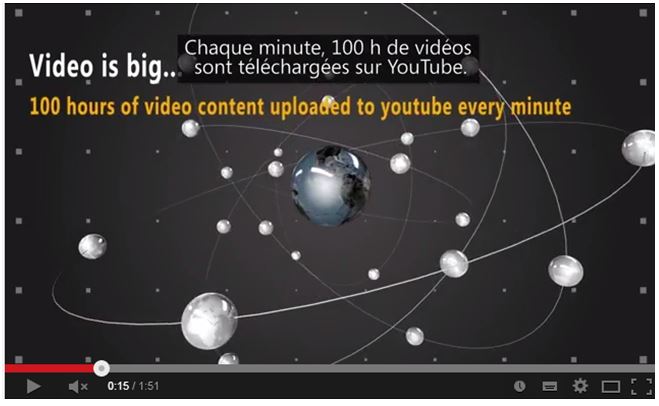 Online video is BIG full stop!
Online video is BIG full stop!
100 million internet users watch online videos every single day, with 100 hours of video footage uploaded to YouTube every minute! What’s more amazing is that 80% of video views on YouTube are actually coming from outside of the United States – and a lot of this traffic is from non-English viewers.
It doesn’t take a genius, then, to realise just how massive an impact translation of your English videos can have on your reach. But that’s not all; the benefits of translating your multimedia content goes beyond merely increasing viewership.
According to a study by Animoto, a whopping 96% of consumers find videos helpful when making purchase decisions online, meaning that you could potentially stand to make a lot of money from leveraging video in your online marketing strategy. That is, of course, if your prospective customers actually understand what the heck is going on in those videos!
Alongside the just published ‘A Guide to Video Translation in Global Digital Marketing Campaigns’ (which is available as a free download), this post aims to highlight five must have features for any international video marketing campaign.
1. Multilingual Content
As strongly alluded to already, if you’re planning on launching your videos on an international scale, the first thing to do is to make your videos accessible to your non-English speaking audience by creating multilingual versions of your content. By using subtitles or multilingual voiceover for your videos you will open up the number of potential viewers who are able to engage with your content.
The flowchart below, taken from the aforementioned guide, gives an indication of the preparation stages that should be in place in order to go about subtitling or voiceover.
 For promotional, creative marketing videos, multilingual voiceover may be a much more appropriate option as it often adds a significantly more personal touch, thereby increasing your chances of engaging emotionally with the local viewer.
For promotional, creative marketing videos, multilingual voiceover may be a much more appropriate option as it often adds a significantly more personal touch, thereby increasing your chances of engaging emotionally with the local viewer.
The workflows for video subtitling and multilingual voiceover are very different, and there are several stages which must be undertaken in order to recreate your video content for an international audience. Download the guide for a more in-depth exploration of these stages.
2. Localised Onscreen Text, Images & Animations
Yes, it’s important to translate the audio content of your videos. But what about any onscreen text, images or animations? It’s important to localise these too. Take the following as an example:
 Here we can see onscreen text in English, plus subtitles in French at this point in the video. There is an English voiceover for this video from which the French subtitles have been produced, however in this case it may have been more beneficial to have the onscreen statistics appear in French rather than having subtitles visible as well.
Here we can see onscreen text in English, plus subtitles in French at this point in the video. There is an English voiceover for this video from which the French subtitles have been produced, however in this case it may have been more beneficial to have the onscreen statistics appear in French rather than having subtitles visible as well.
When it comes to editing onscreen text, images and animations in your video content, it is important to ensure that you have all of the original source files available in order for them to be easily edited and recreated in your target language. Without the source files you may only be able to insert text boxes which overlay the existing text used in your video, and this can look rather messy. Please refer to the guide for further advice on translating the onscreen content of your video.
3. Transcribe and Caption Your Video
Whether you’re hosting your multilingual videos on an online platform such as YouTube or on your own site, you of course want to make sure that your video is picked up in search results. By transcribing and captioning (subtitling) your video you provide the search engines with written content that is readily crawlable and indexable, thereby helping them gain a better understanding of your multimedia content. (And the better the engines understand your content, the more likely it is to rank for relevant queries).
Most online video hosting sites allow you to upload a copy of your script alongside your video. Doing this for your English video will form the basis for your expansion into international video, as this script will be the starting point for the creation of multilingual subtitles or time-coded voiceover documents.
4. International Keyword Research for Video
Direct translations don’t work in international marketing – and multilingual video marketing is no exception. By researching keywords and measuring search volume up against competition, as opposed to merely translating them, you’ll be able to pick relevant, ‘high potential’ keywords for each locale you’re targeting.
Keyword research is also an immensely insightful and powerful undertaking for discovering potential content gaps (i.e. search volume indicates there’s substantial interest in a particular subject, but there’s little quality content for those terms) that can then be used to inform your international video content strategy going forward. It’s important to stress that you need native speakers to carry out this research for you to accurately validate potential opportunities.
Some useful tools to help select appropriate keywords for your video content count the YouTube Keyword Tool and Google’s Keyword Planner. For more detailed information as to how these tools can help you in your search, check out section three of the audiovisual translation guide.
5. Optimising Your Video
Based on your keyword research, through which you should have been able to identify opportunities, you can insert appropriate keywords into your translated captions and script, whilst also optimising the video title, file name, descriptions and tags. Moreover, use schema.org markup for video rich snippets and submit XML video sitemaps:
- The schema.org vocabulary, a structured data markup language supported by Google, Bing, Yahoo! and Yandex, allows you to provide search engines with much more detailed information about your site’s content, including video content. While rich snippets are automatically added to SERPs for video results from YouTube, you will need to use the schema.org/VideoObject to describe videos that are embedded on your own site in order to have one of those cool video thumbnails displayed in search results (note: deploying schema markup is no guarantee of having rich snippets displayed). See guide for implementation example.
- Video sitemaps list web pages on which there’s an embedded video and are essentially ‘extended’ regular sitemaps that allow search engines to better discover and index your video content.
These five stages are essential if you want to maximise the impact of video in your international marketing strategy. The guide offers a really detailed explanation of these five steps to help you make the most of your audiovisual content.









